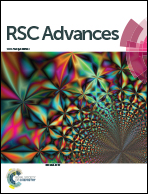Non-doped deep blue light-emitting electrochemical cells from charged organic small molecules†
Abstract
Blue emitters are still elusive for solid-state light-emitting electrochemical cells, and limit the development of white light emitting devices for display applications. We report the photophysical, electrochemical, thermal and electroluminescence properties of two charged organic deep blue-emitters. The synthesized materials showed intense blue fluorescence with high quantum efficiencies and good thermal stabilities. Single-layered non-doped LEC devices were fabricated from solution. The fabricated non-doped LEC devices exhibited deep blue electroluminescence centered at 432 and 434 nm with the CIE coordinates of (0.15, 0.09) and (0.16, 0.10), respectively for compounds 1 and 2, which are quite close to the National Television System Committee (NTSC) standard for blue color coordinates. Electroluminescent devices operated at very low turn-on voltages reveal maximum luminance of 118 cd m−2 for compound 1 and 136 cd m−2 for compound 2. These promising results are highly desirable for the development of low cost white light-emitting devices.


 Please wait while we load your content...
Please wait while we load your content...